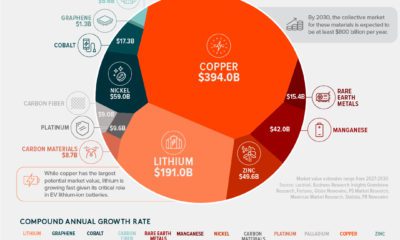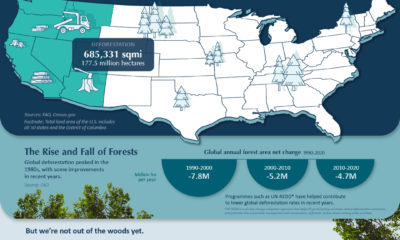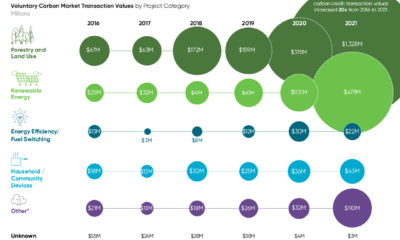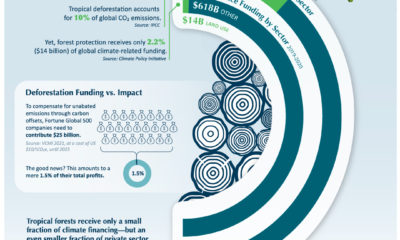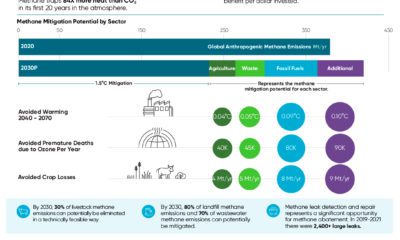The effects of deforestation on the climate are already being seen and felt, and these repercussions are expected to increase with time. That’s why more than 100 world leaders pledged to end and reverse deforestation by 2030 at the COP26 climate summit. As today’s graphic using data from Our World in Data highlights, the world’s forests have been shrinking since the last ice age at an increasingly rapid pace.
Earth’s Surface Area: 10,000 Years Ago
To examine the deforestation situation properly, it helps to understand Earth’s total available surface area. After all, our world can feel massive when glancing at maps or globes. But of the roughly 51 billion hectares in total surface area on Earth, more than 70% is taken up by oceans. What’s left is 14.9 billion hectares of land, not all of which is habitable. Here is how the land was allocated 10,000 years ago, after the last ice age and before the rise of human civilizations. Uninhabitable land on Earth (10,000 years ago):
Barren land (19% or 2.8bn ha)—Includes deserts, salt flats, exposed rocks, and dunes Glaciers (10% or 1.5bn ha)—The vast majority concentrated in Antarctica
Habitable land on Earth (10,000 years ago):
Forest (57% or 6bn ha)—Includes tropical, temperate, and boreal forests Grassland (42% or 4.6bn ha)—Wild grassland and shrubs Freshwater (1% or <510M ha)—Lakes and rivers
By 2018, forests had receded to just 4 billion hectares. What happened?
Forests and Grassland Recede for Agriculture
Once humans figured out how to cultivate plants and livestock for regular sources of food, they needed land to use. For centuries, the loss of greenery was relatively slow. By 1800, the world had lost 700 million hectares each of forest and grassland, replaced by around 900 million hectares of land for grazing animals and 400 million hectares for crops. But industrialization in the 1800s rapidly sped up the process. While half of Earth’s loss of forests occurred from 10,000 years ago to 1900, the other half or 1.1 billion hectares have been lost since 1900. Part of this loss, about 100 million hectares, has occurred in the more recent time period of 2000 to 2018. The biggest culprit? Though urban land use has rapidly grown, it still pales in comparison to the 31% of habitable land now being used for grazing livestock. Most of that land came at first from repurposed grasslands, but forests have also been cleared along the way.
Where Will Food Come From?
Countries pledging to stop deforestation have two major hurdles to solve: financial and survival. Firstly, there are many companies, jobs, and economies that rely on producing and marketing goods made from forests, such as lumber. But more importantly, the world’s rising use of land for crops and agriculture reflects our rapidly growing population. In 1900, the global population numbered just 1.6 billion people. By 2021, it had exceeded 7.9 billion, with hundreds of millions still affected by food shortages every day. How do you feed so many without needing more land? Meat’s extremely large footprint makes prioritizing crops more attractive, and research into other solutions like lab-grown meat and grazing erosion prevention is ongoing. As the effects of climate change become increasingly felt, it’s likely that countries, companies, and people will have to embrace many different solutions at once. on Over recent decades, farmers have been able to more than double their production of crops thanks to fertilizers and the vital nutrients they contain. When crops are harvested, the essential nutrients are taken away with them to the dining table, resulting in the depletion of these nutrients in the soil. To replenish these nutrients, fertilizers are needed, and the cycle continues. The above infographic by Brazil Potash shows the role that each macronutrient plays in growing healthy, high-yielding crops.
Food for Growth
Nitrogen, phosphorus, and potassium (NPK) are three primary macronutrients that are the building blocks of the global fertilizer industry. Each plays a key role in plant nutrition and promoting crop growth with higher yields. Let’s take a look at how each macronutrient affects plant growth. If crops lack NPK macronutrients, they become vulnerable to various stresses caused by weather conditions, pests, and diseases. Therefore, it is crucial to maintain a balance of all three macronutrients for the production of healthy, high-yielding crops.
The Importance of Fertilizers
Humans identified the importance of using fertilizers, such as manure, to nourish crops dating back to nearly 6,000 to 2,400 BC. As agriculture became more intensive and large-scale, farmers began to experiment with different types of fertilizers. Today advanced chemical fertilizers are used across the globe to enhance global crop production. There are a myriad of factors that affect soil type, and so the farmable land must have a healthy balance of all three macronutrients to support high-yielding, healthy crops. Consequently, arable land around the world varies in the amount and type of fertilizer it needs. Fertilizers play an integral role in strengthening food security, and a supply of locally available fertilizer is needed in supporting global food systems in an ever-growing world. Brazil is one of the largest exporters of agricultural goods in the world. However, the country is vulnerable as it relies on importing more than 95% of its potash to support crop growth. Brazil Potash is developing a new potash project in Brazil to ensure a stable domestic source of this nutrient-rich fertilizer critical for global food security. Click here to learn more about fertilizer and food production in Brazil.
